
For visually inclined individuals, drafting can offer a stimulating and creative career path, particularly with the integration of computer-aided design (CAD) and Building Information Modeling (BIM) technologies. Drafting offers fulfilling and innovative avenues for individuals with strong visualization skills and a passion for bringing ideas to life. Contact ITI Technical College today to learn more about creative careers in Drafting.
 Creative Careers In Drafting
Creative Careers In Drafting
Drafting appeals to visual and creative thinkers for many reasons. Drafting positions involve transforming concepts, sketches, and specifications from architects and engineers into precise technical drawings and plans. These individuals use CAD software and their strong abilities to visualize and translate abstract ideas into tangible visual representations, including:
- Spatial Awareness: Drafters need excellent spatial awareness to understand how different components of a design relate to each other in 3D space. This ability is crucial for creating accurate and functional designs and drawings.
- Problem-Solving Through Visualizations: Visualization skills allow drafters to anticipate and solve design problems before they manifest in construction or manufacturing. Thinking visually can unlock creative solutions and improve the quality of designs.
- Drafters Have 3D Modeling Skills: Many drafting professionals use BIM software to create 3D models and facilitate collaboration among project stakeholders. This allows drafters to see designs come to life and offer a visually immersive experience.
Drafting offers various specializations from architectural and civil to mechanical and electrical drafting that cater to a range of visual interests. Individuals can choose a field that resonates with their specific visual strengths and passions.
Examples Of Creative Careers In Drafting
Many career paths are available for trained drafting professionals. Architectural drafters create blueprints for buildings, transforming architectural designs into technical drawings. They work closely with architects and engineers to interpret designs and produce construction documents. Architectural renderers specialize in creating realistic and immersive visual representations of architectural designs using 3D modeling and rendering software.
Civil drafters generate topographical maps and drawings for infrastructure projects like roads, bridges, and dams, and assist with surveying. Electrical drafting consists of preparing drawings and schematics of electrical systems. They work on wiring diagrams, circuit layouts, and contribute to designing and installing electrical systems.
Others may prefer mechanical drafting, where detailed drawings of mechanical devices and machinery are created that include dimensions and assembly instructions. Product designers conceptualize and develop plans and sketches for new products, considering both aesthetics and functionality.
User experience (UX) designers make visual plans for digital products like websites and apps, focusing on usability and user-friendliness. Set designer drafters develop schematics, lighting plots, models, and designs for film and theater sets. They contribute to visually captivating and immersive stage environments.
|
“Drafting offers fulfilling and creative avenues for individuals with strong visualization skills and a passion for turning ideas into reality.” |
Additional Drafting Career Paths You May Like
So far, we have covered conventional drafting career paths, but there are others you may want to consider. They range from automotive designers to structural drafters, including:
- Aerospace Drafter: Aerospace drafters create technical drawings for aircraft and spacecraft. They work on structural components and electrical systems to assist with the development of aerospace technology.
- Automotive Drafter: These drafters create drawings and renderings for vehicle design. They work on conceptual sketches and 3D
 models to contribute to the automobile’s design aesthetic and functionality.
models to contribute to the automobile’s design aesthetic and functionality. - CAD Instructor: CAD instructors teach software skills and drafting techniques to students or professionals. They provide training, develop curricula, and add to the development of CAD skills in the industry.
- CAD Manager: These professionals oversee organizations’ implementation and maintenance of CAD software and systems. They provide technical support, training, and contributions to efficient drafting processes.
- Exhibit Designer: Exhibit designers create visual displays and layouts for museums, exhibitions, and trade shows. They work on space planning, signage, and help ensure engaging and informative visitor experiences.
- HVAC Drafters: These technicians create drawings and plans for heating, ventilation, and air conditioning systems. They work on ductwork layouts, equipment specifications, and contribute to the design of efficient HVAC systems.
- Industrial Designer: These individuals create visual representations of products and consumer goods. They work on product design and ergonomics and contribute to developing aesthetically pleasing and functional objects.
- Landscape Designer: Landscape designers create plans and drawings of outdoor spaces. They work on site layouts, plant selections, and contribute to the design of gardens, parks, and other outdoor environments.
- Marine Drafter: Employees in this profession prepare drawings and plans for shipbuilding and marine structures. They work on naval architecture, vessel layouts, and contribute to constructing and maintaining ships and offshore platforms.
- Structural Drafter: Structural drafters prepare detailed drawings for structural components of buildings and infrastructure. They work on steel, concrete, or timber structures, contributing to safe and functional construction.
A Great Starting Point
Prepare for your drafting career at ITI Technical College in Baton Rouge. Our award-winning school has an excellent Drafting and Design Technology Program to help you find an available entry-level job in this industry.
For more information about graduation rates, the median debt of students who completed the program, and other important information, please visit our website: https://iticollege.edu/disclosures/






